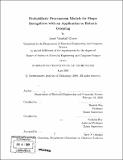Probabilistic procrustean models for shape recognition with an application to robotic grasping
Author(s)
Glover, Jared Marshall
DownloadFull printable version (26.75Mb)
Other Contributors
Massachusetts Institute of Technology. Dept. of Electrical Engineering and Computer Science.
Advisor
Daniela Rus and Nicholas Roy.
Terms of use
Metadata
Show full item recordAbstract
Robot manipulators largely rely on complete knowledge of object geometry in order to plan their motion and compute successful grasps. If an object is fully in view, the object geometry can be inferred from sensor data and a grasp computed directly. If the object is occluded by other entities in the scene, manipulations based on the visible part of the object may fail; to compensate, object recognition is often used to identify the location of the object and compute the grasp from a prior model. However, new instances of a known class of objects may vary from the prior model, and known objects may appear in novel configurations if they are not perfectly rigid. As a result, manipulation can pose a substantial modeling challenge when objects are not fully in view. In this thesis, we will attempt to model the shapes of objects in a way that is robust to both deformations and occlusions. In addition, we will develop a model that allows us to recover the hidden parts of occluded objects (shape completion), and which maintains information about the object boundary for use in robotic grasp planning. Our approach will be data-driven and generative, and we will base our probabilistic models on Kendall's Procrustean theory of shape.
Description
Thesis (S.M.)--Massachusetts Institute of Technology, Dept. of Electrical Engineering and Computer Science, 2008. Includes bibliographical references (p. 92-98).
Date issued
2008Department
Massachusetts Institute of Technology. Department of Electrical Engineering and Computer SciencePublisher
Massachusetts Institute of Technology
Keywords
Electrical Engineering and Computer Science.